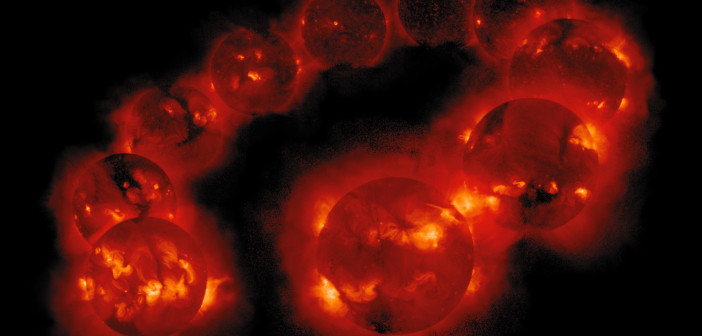Solar-like stars exhibit magnetic cycles; our Sun, for instance, displays an 11-year period in its activity, manifesting as cyclic changes in radiation levels, the number of sunspots and flares, and ejection of solar material. Over the span of two activity cycles, the Sun’s magnetic field flips polarity and then returns to its original state.

An artist’s illustration comparing the Sun to TRAPPIST-1, an ultracool dwarf star known to host several planets. [ESO]
Effects of a Convecting Interior
Dwarf stars have made headlines in recent years due to their potential to harbor exoplanets. Because these cooler stars have lower flux levels compared to the Sun, their habitable zones lie much closer to the stars. The magnetic behavior of these stars is therefore important to understand: could ultracool dwarfs exhibit solar-like activity cycles that would affect planets with close orbits?

The differences in internal structure between different mass stars. Ultracool dwarfs have fully convective interiors. [www.sun.org]
Based on theoretical studies of how magnetism is generated in stars, it’s thought that the fully convective interiors of ultracool dwarfs can’t support large-scale magnetic field formation. This should prevent these stars from exhibiting activity cycles like the Sun. But recent radio observations of dwarf stars have led scientist Matthew Route (ITaP Research Computing, Purdue University) to question these models.
A Reversing Field?
During observations of the brown dwarf star J1047+21 in 2010–2011, radio flares were detected with emission primarily polarized in a single direction. The dwarf’s flares in late 2013, however, all showed polarization in the opposite direction. Could this be an indication that J1047+21 has a stable, global dipolar field that flipped polarity in between the two sets of observations? If so, this could mean that the star has a magnetic cycle similar to the Sun’s.

Artist’s impression showing the relative sizes and colors of the Sun, a red dwarf (M-dwarf), a hotter brown dwarf (L-dwarf), a cool brown dwarf (T-dwarf) similar to J1047+21, and the planet Jupiter [Credit: NASA/IPAC/R. Hurt (SSC)]
If this is indeed true, then we need to examine our models of how magnetic fields are generated in stars: the interface between the radiative and convective layers may not be necessary to produce large-scale magnetic fields. Understanding this process is certainly an important step in interpreting the potential habitability of planets around ultracool dwarfs.
Citation
Matthew Route 2016 ApJL 830 L27. doi:10.3847/2041-8205/830/2/L27

3 Comments
Pingback: Enanas ultrafrías « SEDA / LIADA
Pingback: Jupiter's Internal Powerhouse and Ultracool Dwarfs | Andy-Lloyd.comAndy-Lloyd.com
Pingback: Vertonen ultrakoele dwergsterren zonachtig gedrag?